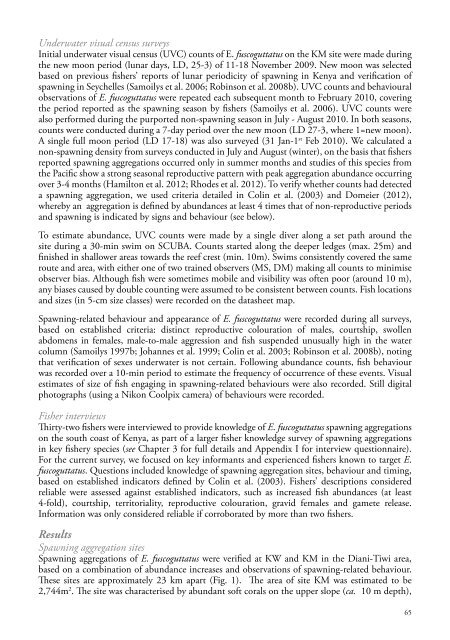WIOMSA-CORDIO spawning book Full Doc 10 oct 13.pdf
WIOMSA-CORDIO spawning book Full Doc 10 oct 13.pdf
WIOMSA-CORDIO spawning book Full Doc 10 oct 13.pdf
You also want an ePaper? Increase the reach of your titles
YUMPU automatically turns print PDFs into web optimized ePapers that Google loves.
Underwater visual census surveysInitial underwater visual census (UVC) counts of E. fuscoguttatus on the KM site were made duringthe new moon period (lunar days, LD, 25-3) of 11-18 November 2009. New moon was selectedbased on previous fishers’ reports of lunar periodicity of <strong>spawning</strong> in Kenya and verification of<strong>spawning</strong> in Seychelles (Samoilys et al. 2006; Robinson et al. 2008b). UVC counts and behaviouralobservations of E. fuscoguttatus were repeated each subsequent month to February 20<strong>10</strong>, coveringthe period reported as the <strong>spawning</strong> season by fishers (Samoilys et al. 2006). UVC counts werealso performed during the purported non-<strong>spawning</strong> season in July - August 20<strong>10</strong>. In both seasons,counts were conducted during a 7-day period over the new moon (LD 27-3, where 1=new moon).A single full moon period (LD 17-18) was also surveyed (31 Jan-1 st Feb 20<strong>10</strong>). We calculated anon-<strong>spawning</strong> density from surveys conducted in July and August (winter), on the basis that fishersreported <strong>spawning</strong> aggregations occurred only in summer months and studies of this species fromthe Pacific show a strong seasonal reproductive pattern with peak aggregation abundance occurringover 3-4 months (Hamilton et al. 2012; Rhodes et al. 2012). To verify whether counts had detecteda <strong>spawning</strong> aggregation, we used criteria detailed in Colin et al. (2003) and Domeier (2012),whereby an aggregation is defined by abundances at least 4 times that of non-reproductive periodsand <strong>spawning</strong> is indicated by signs and behaviour (see below).To estimate abundance, UVC counts were made by a single diver along a set path around thesite during a 30-min swim on SCUBA. Counts started along the deeper ledges (max. 25m) andfinished in shallower areas towards the reef crest (min. <strong>10</strong>m). Swims consistently covered the sameroute and area, with either one of two trained observers (MS, DM) making all counts to minimiseobserver bias. Although fish were sometimes mobile and visibility was often poor (around <strong>10</strong> m),any biases caused by double counting were assumed to be consistent between counts. Fish locationsand sizes (in 5-cm size classes) were recorded on the datasheet map.Spawning-related behaviour and appearance of E. fuscoguttatus were recorded during all surveys,based on established criteria: distinct reproductive colouration of males, courtship, swollenabdomens in females, male-to-male aggression and fish suspended unusually high in the watercolumn (Samoilys 1997b; Johannes et al. 1999; Colin et al. 2003; Robinson et al. 2008b), notingthat verification of sexes underwater is not certain. Following abundance counts, fish behaviourwas recorded over a <strong>10</strong>-min period to estimate the frequency of occurrence of these events. Visualestimates of size of fish engaging in <strong>spawning</strong>-related behaviours were also recorded. Still digitalphotographs (using a Nikon Coolpix camera) of behaviours were recorded.Fisher interviewsThirty-two fishers were interviewed to provide knowledge of E. fuscoguttatus <strong>spawning</strong> aggregationson the south coast of Kenya, as part of a larger fisher knowledge survey of <strong>spawning</strong> aggregationsin key fishery species (see Chapter 3 for full details and Appendix I for interview questionnaire).For the current survey, we focused on key informants and experienced fishers known to target E.fuscoguttatus. Questions included knowledge of <strong>spawning</strong> aggregation sites, behaviour and timing,based on established indicators defined by Colin et al. (2003). Fishers’ descriptions consideredreliable were assessed against established indicators, such as increased fish abundances (at least4-fold), courtship, territoriality, reproductive colouration, gravid females and gamete release.Information was only considered reliable if corroborated by more than two fishers.ResultsSpawning aggregation sitesSpawning aggregations of E. fuscoguttatus were verified at KW and KM in the Diani-Tiwi area,based on a combination of abundance increases and observations of <strong>spawning</strong>-related behaviour.These sites are approximately 23 km apart (Fig. 1). The area of site KM was estimated to be2,744m 2 . The site was characterised by abundant soft corals on the upper slope (ca. <strong>10</strong> m depth),65


















